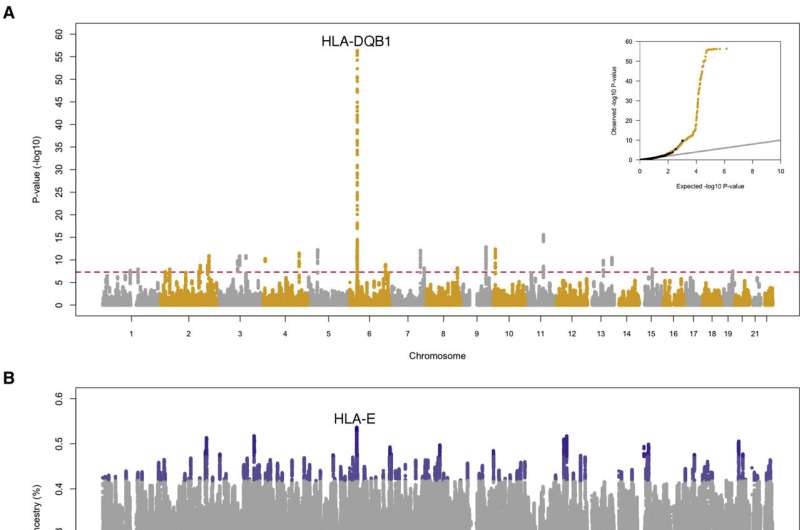This article has been reviewed according to Science X's editorial process and policies. Editors have highlighted the following attributes while ensuring the content's credibility:
fact-checked
peer-reviewed publication
trusted source
proofread
Hunter-gatherer genes helped early European farmers survive disease, reveals study

When early Stone Age farmers first moved into Europe from the Near East about 8,000 years ago, they met and began mixing with the existing hunter-gatherer populations. Now genome-wide studies of hundreds of ancient genomes from this period show more hunter-gatherer ancestry in adaptive-immunity genes in the mixed population than would be expected by chance.
The findings, reported in Current Biology on March 23, suggest that mixing between the two groups resulted in mosaics of genetic variation that were acted upon by natural selection, a process through which all organisms, including humans, adapt and change over time.
The changes in immunity genes appeared in the major histocompatibility complex (MHC) region, a cluster of genes that code for surface proteins on cells and help our immune systems recognize pathogens. The researchers also detected more farmer ancestry in a gene called SLC24A5, which is involved in skin pigmentation.
"This tells us that these regions of the genome were experiencing natural selection," said Tom Davy of the Francis Crick Institute's Ancient Genomics Laboratory in London. "The genetic variants predominantly carried by hunter-gatherers in the MHC region and by farmers in SLC25A5 increased in frequency in the descendant population."
In recent years, the study of ancient genomes has allowed scientists to essentially travel back in time to trace the evolution of humans and other organisms. Whereas most ancient DNA studies have focused on archaeological questions, Davy and Pontus Skoglund at the Francis Crick Institute and Iain Mathieson and colleagues of the University of Pennsylvania realized that the increasing availability of standardized and shared ancient genome data now allows new questions about natural selection and human adaptation in prehistoric times.
They analyzed genome-wide DNA from 677 individuals spanning Mesolithic and Neolithic Europe. Their goal was to look for any ancestry deviations in the genomes of admixed individuals and to test whether those deviations appeared to be the result of natural selection, as opposed to random changes.
Their analysis found that a pigmentation-associated gene was the most overrepresented from the Neolithic local ancestry. In contrast, the mixed group retained more genes from the important MHC immunity locus from the hunter-gatherers. The findings could simply reflect the advantage of having more diversity in immune response, the researchers say. On the other hand, the MHC alleles from the hunter-gatherers might have been positively selected for because they facilitated greater survival and adaptation to pathogens in the Neolithic group.
Although other factors may have been at play, the findings highlight immune function as a prime target of natural selection in late-Stone-Age populations. The researchers say the increased immune representation from hunter-gatherers came as something of a surprise to them.
"A longstanding idea is that farming lifestyles drove immune adaptation due to denser settlements, new diets, and proximity to livestock," Skoglund said. "When farming groups expanded from the Near East into Europe and mixed with local hunter-gatherers, the natural prediction would be that the farmers' immunity genes would be best adapted to the farming lifestyle and thus selected for. However, we see the opposite, that hunter-gatherer ancestry is enriched at the MHC immunity locus. This could, for example, be because the hunter-gatherers were already adapted to pathogens found in Europe, or it could be the result of natural selection favoring diversity in immunity genes."
As for changes in pigmentation, earlier studies also had shown selection for reasons that aren't fully understood. "One hypothesis is that lighter skin pigmentation allowed farmers to synthesize more vitamin D from ultraviolet radiation, while hunter-gatherers were able to obtain sufficient vitamin D from their diet," Mathieson says.
Overall, the new study extends recent findings of adaptive admixture at the MHC region to selection in a Stone Age human population for the first time. The researchers say the discovery of greater diversity at the MHC locus opens new avenues for understanding the adaptations that came along with the shift to an agricultural lifestyle, which the researchers note was a fundamental transition that happened worldwide in human history.
"This study revealed natural selection during the agricultural transition in one region of the world, Europe, but other regions are not well understood," Skoglund said. "Future ancient-DNA studies will also be able to address to what extent immunity was a key target also in other periods of environmental and lifestyle change during human evolution."
More information: Pontus Skoglund, Hunter-gatherer admixture facilitated natural selection in Neolithic European farmers, Current Biology (2023). DOI: 10.1016/j.cub.2023.02.049. www.cell.com/current-biology/f … 0960-9822(23)00189-6
Journal information: Current Biology
Provided by Cell Press





















